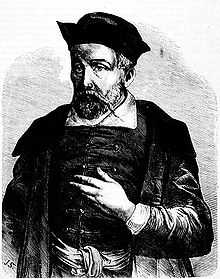Michał Sędziwój
| Michał Sędziwój | |
|---|---|
 | |
| Born |
February 2, 1566 Łukowica, Kingdom of Poland |
| Died |
1636 Kravaře, Holy Roman Empire |
| Nationality | Polish |
| Other names | Michael Sendivogius, Cosmopolita |
| Occupation | Alchemist, philosopher, writer, and medical doctor. |
Michał Sędziwój (Michael Sendivogius, Sędzimir) (1566–1636) of Ostoja coat of arms was a Polish alchemist, philosopher, and medical doctor. A pioneer of chemistry, he developed ways of purification and creation of various acids, metals and other chemical compounds. He discovered that air is not a single substance and contains a life-giving substance-later called oxygen 170 years before similar discoveries by Scheele and Priestley. He correctly identified this 'food of life' with the gas (also oxygen) given off by heating nitre (saltpetre). This substance, the 'central nitre', had a central position in Sędziwój's schema of the universe.
Biography
Little is known of his early life: he was born in a noble family that was part of the Clan of Ostoja. His father sent him to study in university of Kraków but Sędziwój visited also most of the European countries and universities; he studied in Vienna, Altdorf, Leipzig and at Cambridge. His acquaintances included John Dee and Edward Kelley. It was thanks to him that King Stefan Batory agreed to finance their experiments.[1] In the 1590s he was active in Prague, at the famously open-minded court of Rudolf II.

In Poland he appeared at the court of King Sigismund III Vasa around 1600, and quickly achieved great fame, as the Polish king was himself an alchemy enthusiast and even conducted experiments with Sędziwój. In Kraków's Wawel castle, the chamber where his experiments were performed is still intact. The more conservative Polish nobles soon came to dislike him for encouraging the king to expend vast sums of money on chemical experimentation. The more practical aspects of his work in Poland involved the design of mines and metal foundries. His widespread international contacts led to him employment as a diplomat from about 1600.
In his later years, Sędziwój spent more time in Bohemia and Moravia (now in the Czech Republic), where he had been granted lands by the Habsburg emperor. Near the end of his life, Sędziwój settled in Prague, in the court of Rudolf II, where he gained even more fame as a designer of metal mines and foundries. However the Thirty Years' War of 1618-48 had effectively ended the golden age of alchemy: the rich patrons now spent their money on financing war rather than chemical speculation, and Sędziwój died in relative obscurity.
Works
Daniel Stolcius in his Viridarium Chymicum (1624) praises Sędziwój as the author of twelve books.[2] The most famous of these was his "New Chemical Light", published in 1604. Besides a relatively clear exposition of Sędziwój's theory on the existence of a 'food of life' in air, his books contain various scientific, pseudo-scientific and philosophical theories, and were repeatedly translated and widely read among such worthies as Isaac Newton into the 18th century.
Major Works
- De Lapide Philosophorum Tractatus duodecim e naturae fonte et manuali experientia depromti (1604). Also known as Novum Lumen Chymicum (New Chemical Light), the first Latin editions were published simultaneously in Prague and Frankfurt.[3]
- Dialogus Mercuriii, Alchemistae et Naturae (Cologne, 1607)
- Tractatus de sulphure altero naturae principio (Cologne, 1616)
Sędziwój in fiction

First appearance of this character in fiction was in an 1845 book "Sędziwoj" by Józef Bohdan Dziekoński, a writer during the times of romanticism in Poland. Nowadays he appears in several books by Polish writer Andrzej Pilipiuk (Kuzynki, Księżniczka, Dziedziczki). He was also shown (thinly disguised) as the Alchemist Sendivius in the Polish TV series in the 1980s.
The Polish 19th century realist painter Jan Matejko depicted Sędziwój demonstrating a transmutation of a base metal into gold before King Sigismund III Vasa.
Sendivogius is also a character in the novel of Gustav Meyrink (part of Goldmachergeschichten, August Scherl Verlag, Berlin 1925), a German author from Prague, Bohemia, who often wrote about alchemy and alchemists.
Sendivogius is the central character in the 2012 fictional conspiracy thriller The Man With the Devil's Hand by Jarek Garliński, a Polish-English author and translator, who mainly specialises in Polish history during the Second World War.
See also
References
- ↑ Praktyk i mistyk, Andrzej Datko, Wiedza i życie 2008-04-28 | http://portalwiedzy.onet.pl/4868,12799,1483961,1,czasopisma.html (in Polish)
- ↑ Rafal T. Prinke, MICHAEL SENDIVOGIUS and CHRISTIAN ROSENKREUTZ The Unexpected Possibilities, The Hermetic Journal, 1990, 72-98
- ↑ Rafal T. Prinke, MICHAEL SENDIVOGIUS and CHRISTIAN ROSENKREUTZ The Unexpected Possibilities, The Hermetic Journal, 1990, 72-98
Sources
- Michael Sendivogius, The Alchemical Letters of Michael Sendivogius to the Rosicrucian Society, Holmes Pub Group Llc, ISBN 1-55818-404-X
- Zbigniew Szydlo, Water which does not wet hands. The alchemy of Michael Sendivogius, London-Warsaw 1994
- Rafal T. Prinke, MICHAEL SENDIVOGIUS and CHRISTIAN ROSENKREUTZ The Unexpected Possibilities, The Hermetic Journal, 1990, 72-98
- Zbigniew Szydlo, Woda, która nie moczy rąk. Alchemia Michała Sędziwoja., Wydawnictwa Naukowo-Techniczne, Warszawa 1997.
External links
- www.sendivogius.pl - website about the life and works of MIchal Sedziwoj
- MICHAEL SENDIVOGIUS and CHRISTIAN ROSENKREUTZ The Unexpected Possibilities online
- LETTERS OF MICHAEL SENDIVOGIUS TO THE ROSEYCRUSIAN SOCIETY FOUND IN AN OLD MANUSCRIPT BY EBENEZER SIBLY M.D. 1791
- A letter from Michael Sendivogius to Vincenzo II Gonzaga, duke of Mantua (1562-1612)
- Tadeusz Gajl Herbarz, herb Sędzimir
- The 16th Century Alchemist Who Discovered Oxygen
|